|
Interview
Wakilur Rahman
Fragments of Space
Fayza Haq
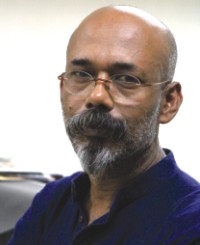 |
Wakilur Rahman |
A painter and printmaker, Wakilur Rahman has been dividing his time between Dhaka and Berlin since 1988. Although based in Berlin for the last 22 years where he has made a name for himself, he is often lured back to his motherland where he is an important presence in the local art scene. His recent exhibition that started on September 23 and ends October 12 is titled 'In Books, You can Read'. On his recent visit the artist speaks to Fayza Haq about his work and the messages he wishes to portray through them.
To what extent should an artist create works for his own satisfaction or should he work with the tastes of the critiques, viewers and patrons in mind?
The artist should show what is normally not noticed by everyone, in my view. The artist should visualise and focus on them. It should seep into their minds and leave an indelible mark. It is part of our life; it must have new meaning; it should have a different context. Only then does the audience begin to think about it. My artistic view is to show something, to get a space that the audience can think about. The main thing is to get a subject and make the audience think about it. If we sit in this room, there is some corner, which we never use, but this corner bears some expression. You can use this for different purposes.
It is not easy for viewers to grasp this. But I think that the audience is moving with their habits. They have already been exposed to modern concepts of installations and nouveau concepts of fine arts, since I had my exhibition at Dhaka Art College, when I had very different things to offer the viewer. Twenty-five years later, my style and views are very different now. In every exhibition, I try to show a theme – in a different way. This means how I hang the two-dimensional painting or expose the three-dimensional work: how I use the gallery space. I try to make the design connected with the concept of something new, something fresh. The idea in my mind always dwells on man, nature, hopes and dreams. This is connected with the past.
You had a mind-whirling exhibition at “Chitrak” in the recent past. What was it about?
This was in 2006 or around that time. The exhibition was called “Counter Space”. “Chitrak Gallery” has four rooms and connecting corridors. It was not built for a gallery; it was a house: it has been rearranged and used today as a gallery. I emptied the rooms. Next I put some wooden strips on the wall. There is a journey from one room to another. This space was filled with my work: the empty space was important. There must be an eye-rest and not a mélange of paintings or sculpture spaces. My words were placed in such a way that the corner space was stressed upon. I wanted to show that conceptually the corner can be creative. The contrast of paintings, with their light and shade made designs and created different designs. Hence there was a dialogue between spaces in the gallery.
Elaborate on the one in the gallery of Alliance Francaise.
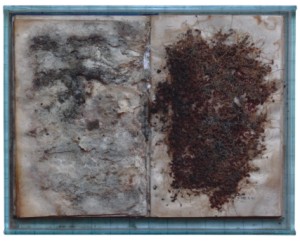 “La Gallerie”, Alliance Francaise, had an exhibition of mine in 1994 or 1995. In 2007, another exhibition contained painting on paper, large sized and fixed directly on the wall. It contained Bengali calligraphy – stressing on the various forms. I focused on the abstraction of the forms of different words. The sound and letterings of Bengali words have different aspects. When you speak it forms a sound. When you write, it is something elseas I believe. As we know the form of the writing we can communicate as a language. I also used English and Latin words in the subject. In one of the paintings, I used words from books by Tagore; I collected the words from a dictionary and made a painting . This was a journey through the whole of Bengal, “Chinna Patra”. The vital elements are the river, the season, the gypsy: The whole thing is presented as a journey of life. This is vital for Bangladesh, I believe. “La Gallerie”, Alliance Francaise, had an exhibition of mine in 1994 or 1995. In 2007, another exhibition contained painting on paper, large sized and fixed directly on the wall. It contained Bengali calligraphy – stressing on the various forms. I focused on the abstraction of the forms of different words. The sound and letterings of Bengali words have different aspects. When you speak it forms a sound. When you write, it is something elseas I believe. As we know the form of the writing we can communicate as a language. I also used English and Latin words in the subject. In one of the paintings, I used words from books by Tagore; I collected the words from a dictionary and made a painting . This was a journey through the whole of Bengal, “Chinna Patra”. The vital elements are the river, the season, the gypsy: The whole thing is presented as a journey of life. This is vital for Bangladesh, I believe.
Next I took a page from the “Kama Sutra”, in English. I played with the colour and form of the language. I wrote with special colours. I did a painting with only three Bengali words. I took “Batash” (wind) “ Megh”(cloud) and “Jal”(water). When one makes a landscape painting it contains these three elements. I used “Akash” (sky) and “Batash” (wind) which we don't see, but is always there. I used these three words to make a landscape painting. I wrote these words and made a painting out of it. I tried to make a new type of landscape painting: viewers can imagine in their way: on top is the sky; in the middle there is the wind; below there is water. In the calligraphy there is an idea behind why I chose these words. This is because these words have their own power. “Akash” itself has a very poetic, imaginative and musical connotation.”
How deeply have you studied calligraphy?
I studied in Peking, China for three years. The Chinese have a long tradition of calligraphy. I used Bengali words and I got a lot of inspiration from Chinese black and white paintings. We too have a long tradition of the written word.
What were your teachers like in Peking?
I was there from 1993 to 1996, when China was very traditional, academic and very realistic in vision, as regards to painting. I feel that I learnt academic work quite well, there in Peking. It was good for creating a base: to build up my confidence in myself. Side by side I studied Chinese philosophy, their Buddhism, their traditional words and their aesthetics. The Chinese culture, as is well known, is one of the oldest cultures. I was also interested in Korean and Japanese cultures, which are affiliated to the Chinese. I spoke to them and exchanged ideas and views, and studied their work. All this had a large impact on my mind. It
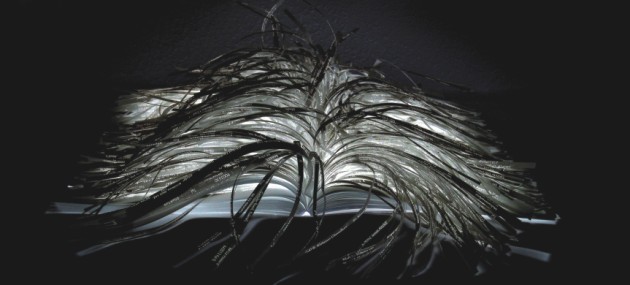
Shabdo Bhumi Detail
was very interesting for me. I absorbed their thinking processes, harmony, the colour, music: their lifestyle, that is.
Lately, in the Muktijuddho Jadughar (Liberation War Museum) you had yet another unique exhibition. This was your first installation work. What was this about?
As of late, I have been doing space oriented installation artwork. This was earlier in 1997 and much more recently, with “Prothom Alo” as the patron. This was called “Kagojer Chaya”. This was at the “Jatio Jadughor” (National Museum) in 2009.
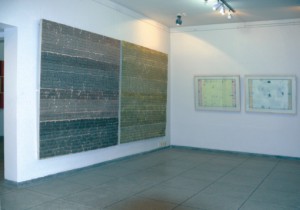 |
Exhibition |
Reading on the 1971 War and its impact, from Berlin, days together, I felt that those who had actually taken part in the War of Liberation, that had a great impact on them. For instance, I collected the story of the rickshaw- puller, who actually took part in the war. He might have been three months old, and he might have lost his leg. He might not have actually seen the war but life remains a touching one, as he limps, while he walks. With these personal moving stories I created a book of a single colour. I made various books, of various colours, and hung them in the gallery. When the viewers read the books, they left their footprints on the white cloth, which was there under their feet. In this manner, I wanted the viewers to be close to the books – and with the “Muktijuddha Kahini”, I felt that the Liberation War has a place of its own in the history of Bangladesh.
Later on, the work at the National Museum was a similar installation – type work.
I did this along with Dhali Al Mamun, a professor from Chittagong. The idea was to use the media, which no one can deny is powerful. We used the material of their reports, design etc to arrange the entire exhibition. More than 13,000 viewers turned up for this exhibition. We had tremendous amount of self-satisfaction, as we managed to put across the message. It was the first time that I had worked with a corporate, and organisation like “Prothom Alo”, who gave us carte blanche with our work.”
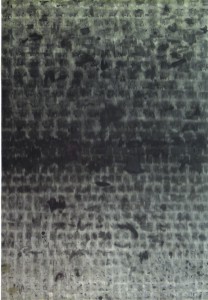 |
Water and Wind - 2 |
Do you find total contentment in Berlin or do you feel it is necessary to go back to your roots in Bangladesh?
Due to the fact that the Internet is very developed, I am in constant touch with Bangladesh. In the morning I read newspapers; I exchange news with my friends on the Internet; I phone my friends. In this manner, I am close to my friends back home. Often, me and my friends from Bangladesh have a wonderful time. I visit Bangladesh, at least once a year, during the autumn or winter season. When I come to Bangladesh, I hold an exhibition, which I've planned earlier in Berlin. I think about the space, subject etc.
What have you come for this time?
I've come for a commissioned work, which I'll not speak about at the moment: I want the viewers to be surprised.
What was it like for you before, in Dhaka, your training place – before you took off for Peking?
I did my Honours from Dhaka Art College. At that time, the Painting Department was headed by Abdul Baset. It had Rafiqun Nabi and Dr. Farida Zaman. My experience with Shahid Kabir, when I was a second year student and Aminul Islam, was tremendous.
Copyright
(R) thedailystar.net 2010 |
